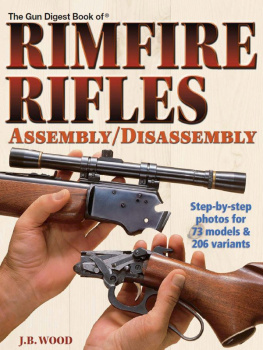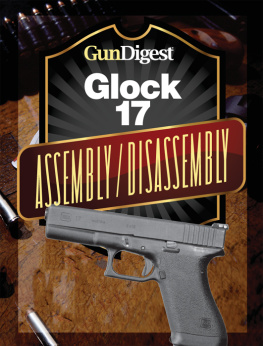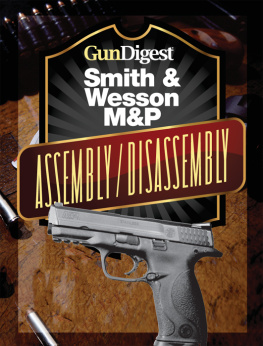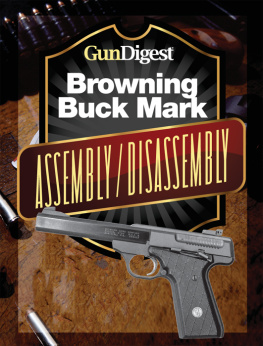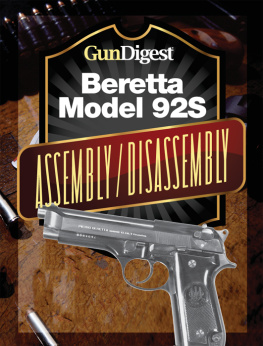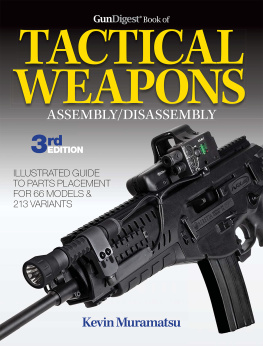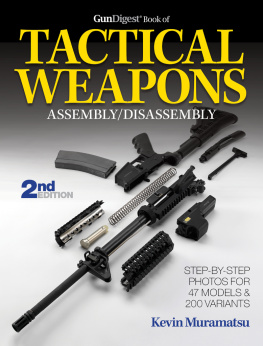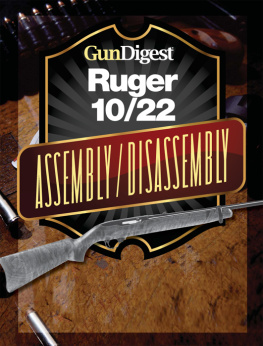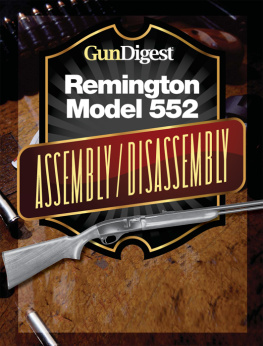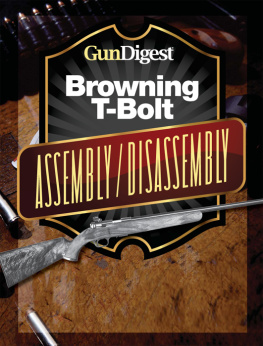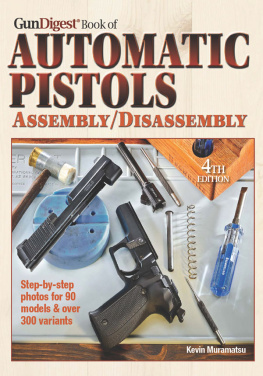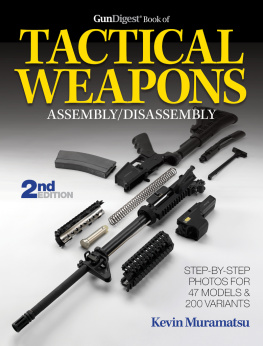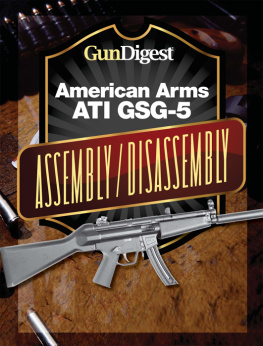
The Gun Digest Book of
RIMFIRE
RIFLES
ASSEMBLY/DISASSEMBLY
J.B. WOOD
2006 by
Gun Digest Books
Published by

700 East State Street Iola, WI 54990-0001
715-445-2214 888-457-2873
www.gunlistonline.com
Our toll-free number to place an order or obtain a free catalog is 800-258-0929.
All rights reserved.
No portion of this publication may be reproduced or transmitted in any form or by any means, electronic or mechanical, including photocopy, recording, or any information storage and retrieval system, without permission in writing from the publisher, except by a reviewer who may quote brief passages in a critical article or review to be printed in a magazine or newspaper, or electronically transmitted on radio, television, or the Internet.
CAUTION: Technical data presented here, particularly technical data on handloading and on firearms adjustment and alteration, inevitably reflects individual experience with particular equipment and components under specific circumstances the reader cannot duplicate exactly. Such data presentations therefore should be used for guidance only and with caution. Gun Digest Books accepts no responsibility for results obtained using these data.
Library of Congress Catalog Number: 2005906858
ISBN 13: 978-0-89689-294-1
ISBN 10: 0-89689-294-8
eISBN: 978-1-44022-4-669
Designed by Patsy Howell
Edited by Ken Ramage
Printed in the United States of America
Dedication
The book is dedicated to Rolan Bennett, Bill Book, Chick
Evans, Jim Edlin, Paul James, and the times that used to be.
Contents
Introduction
Every gunsmith is familiar with what might be called the sack-of-parts syndrome. Customers frequently arrive with guns totally or partially disassembled, in all manner of containers. I have seen them in cigar boxes, paper sacks, plastic bags, glass jars, and once in an aluminum vase, the type used to put flowers on graves. In most cases, the reason for the complete takedown was cleaning, and the unfortunate owner then couldnt remember the proper position of all those small parts and springs.
If the owner had the manual or instruction sheet supplied with each new gun, it was often of little help, as most of these go only as far as simple field-stripping,. For some of the older guns, the manuals are scarce collector items, and are not readily obtainable. With some imported guns, the direct-translation sheets are amusing to read, but nearly useless as a guide. Good, clear instructions on total takedown and reassembly were obviously needed, and this is the idea behind this series of books. Volumes I and II cover pistols and revolvers, and the next two books in the series cover centerfire rifles and shotguns.
In complete disassembly and reassembly, there are some points that may require the special tools and skills of the gunsmith. A very knowledgeable amateur can usually manage it, but he must have some mechanical aptitude. This book is intended for both the average gun person and the professional, and for this reason even the simpler operations are described and shown in detail.
Some of the tools required are of a type not readily available at the local hardware store, so I am including a section on tools, and giving the sources from which they may be obtained.
In the takedown of any gun, there are a few general rules which apply. A light tap with a plastic mallet may sometimes be necessary to free a tight assembly, but no extreme force should be used. Always wear safety glasses to protect the eyes from parts expelled by compressed springs. Do not disassemble a gun outdoors, over tall grass, or indoors, over a shag rug. Before you start, read the instructions through, all the way, at least once.
I assume that my readers are sufficiently intelligent not to work on a loaded gun, so I will not begin each set of instructions by repeating that the gun must be entirely unloaded. Ill say it once, right here: Before you begin the disassembly of any gun, be sure that all cartridges are removed. Dont trust the feed and ejection systems make a thorough visual inspection. Some tube-magazine types can hide a round in the mechanism.
An important addition to the back of this book is a comprehensive index and cross-reference list, linking all of the rifles covered here to guns of similar or identical pattern. When these are included in the count, the instructions in this revised edition can be used for the takedown and reassembly of hundreds of rifles.
The Gun Digest Book of Exploded Gun Drawings, also available from Krause Publications, is an excellent companion to this book, showing parts relationships and factory part numbers for 975 guns.
J.B. Wood
Raintree House
Corydon, Kentucky
December, 2005
A Note on Reassembly
Most of the rifles covered in this book can be reassembled by simply reversing the order of disassembly, carefully replacing the parts in the same manner they were removed. In a few instances, special instruction are required, and these are listed with each gun under Reassembly Tips. In certain cases, reassembly photos are also provided.
If there are no special instructions or photos with a particular gun, you may assume that it can just be reassembled in reverse order. During disassembly, note the relationship of all parts and springs, and lay them out on the workbench in the order they were removed. By following this procedure you should have no difficulty.
Acknowledgements
John S. Yarger, John A. Yarger, James W. Yarger, and Larry McClarney of Lock & Load Gun Shop, Al Paulsen, Glenn Lancaster, Thomas M. Brown, James W. Wood, A. D. Jenkins Sr., Ron Fine of Mossberg, Jack Sharry of Harrington & Richardson, Stanley Hopper of Family Sporting Goods, Carl Bonnell and Jessie Smith of Sportsmans Corner, Gene Wilson, Joe Burton, John Cole of Daisy Manufacturing, Ernie Barriage of Lakefield Arms, Paul Thompson of Browning, Bill Wohl and Teressa Carter of Remington, Larry Larson of Armscor Precision, Jerry Stern of Action Arms, Rich Krieg of Federal Engineering, Mike Miller of Calico, Merv Chapman of Feather Industries, George Kellgren of Grendel, Rick Krouse of Kintrek, Charles E. Minton, Philip M. Shannon, Mary Alice Casey, Major Terah Flaherty, Tony Aeschliman of Marlin, Jason Morton of CZ-USA, Harold A. Murtz, Daniel A. Murtz, Bob Morrison and Ron Vogel of Taurus, Bob Gustafson and Larry Weishuhn of Thompson/Center, Brian Herrick of Savage, Margaret Sheldon of Ruger, Anthony Imperato of Henry Repeating Arms, John Huff, Barbara Hazelrigg, Brenda Bryant and Steve Bryant of Fast Foto Finishing.
TOOLS

Countless firearms, old and new, bear the marks, burrs and gouges that are the result of using the wrong tools for taking them apart. In the interest of preventing this sort of thing, I am including here a group of tools that are the best types for the disassembly of rifles. Except for the few shop-made tools for special purposes, all of those shown here are available from one of these three sources.
| Brownells, Inc. | B-Square Company | Williams Gun Sight Company |
| 200 South Front Street | P.O. Box 11281 | 7389 Lapeer Road |
| Montezuma, IA 50171 | Fort Worth, TX 76109 |
Next page
